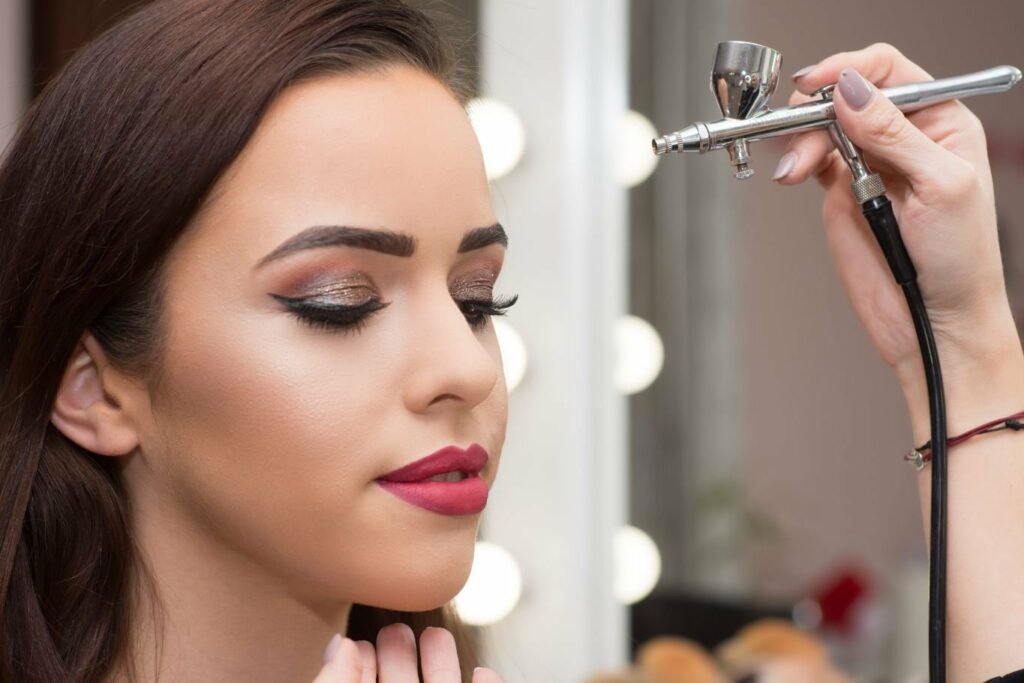Airbrush makeup provides a flawless, long-lasting finish favored by professionals for its precision and durability, while traditional makeup offers a classic, versatile application method that many individuals prefer for its ease of use and familiarity. Both techniques have their merits and the choice between the two depends on personal preference, skin type, and occasion.
We will explore the differences in application, longevity, and suitability for different skin types, helping you make an informed decision about which makeup method is best for you. Whether you’re a makeup artist looking to expand your skills or an individual interested in perfecting your makeup routine, understanding the distinctions between airbrush and traditional makeup is essential for achieving a flawless, professional look.
Contents
- 1 The Rise Of Airbrush Makeup
- 2 Application Techniques
- 3 Coverage And Finish
- 4 Longevity And Durability
- 5 Pros And Cons
- 6 Frequently Asked Questions
- 6.1 What Are The Benefits Of Airbrush Makeup Over Traditional Makeup?
- 6.2 Is Traditional Makeup Better For Covering Skin Imperfections?
- 6.3 Do Airbrush Makeup Applications Look Natural In Photos And Videos?
- 6.4 How Does The Longevity Of Airbrush Makeup Compare To Traditional Makeup?
- 6.5 Can Traditional Makeup Achieve The Same Lightweight Feel As Airbrush Makeup?
- 7 Conclusion
The Rise Of Airbrush Makeup
Airbrush makeup has gained immense popularity in the beauty industry, offering a flawless and long-lasting finish. As technology advances, airbrush makeup has become the go-to choice for many makeup artists and enthusiasts. The precision, durability, and seamless application of airbrush makeup have led to its widespread adoption in various realms, from bridal makeup to theatrical performances.
History Of Airbrush Makeup
The origins of airbrush makeup can be traced back to the early 20th century when it was primarily used in the realm of body art and theatrical makeup. However, it was not until the 1980s that airbrush makeup gained recognition in the mainstream beauty industry. With its ability to create a natural and radiant look, airbrush makeup became a game-changer, transforming the way makeup was applied for special events, photoshoots, and film productions.
Technology Behind Airbrush Makeup
The technology behind airbrush makeup revolves around the use of an air compressor that delivers a fine mist of makeup onto the skin, creating a smooth and even coverage. The makeup is atomized into tiny particles, resulting in a lightweight and breathable layer that offers impeccable coverage. The seamless blending and adjustable pressure settings of airbrush makeup allow for a customized application, catering to individual skin tones and preferences.
Application Techniques
When it comes to makeup application techniques, understanding the differences between airbrush and traditional makeup is essential. Each method has its own unique approach to achieving a flawless look, and it’s important to consider their distinct application techniques before making a choice. Let’s dive into the specific application processes for airbrush and traditional makeup.
Airbrush Makeup Application Process
Airbrush makeup application involves using an air compressor to spray a fine mist of makeup onto the skin. This technique creates a seamless, lightweight finish that is highly blendable and long-lasting. The steps involved in airbrush makeup application typically include:
- Preparing the airbrush gun and makeup products
- Priming the skin with a moisturizer or primer
- Applying the airbrush makeup in thin layers for buildable coverage
- Blending the makeup evenly for a natural and flawless look
- Setting the makeup with a finishing spray for longevity
Traditional Makeup Application Techniques
Traditional makeup application involves using brushes, sponges, or fingertips to apply makeup directly onto the skin’s surface. This method allows for precise and detailed application, with a wide range of products and finishes available. The techniques for traditional makeup application typically include:
- Prepping the skin with skincare products and primer
- Using brushes or sponges to apply foundation, concealer, and other makeup products
- Blending the makeup to achieve a seamless and natural look
- Setting the makeup with powders or setting sprays for longevity
Coverage And Finish
When considering airbrush and traditional makeup, it’s important to understand the differences in coverage and finish. These aspects play a significant role in achieving the desired look and longevity of the makeup. Let’s break down the comparison and understand how the two methods differ in their coverage and finish.
Coverage Comparison
One of the key differences between airbrush and traditional makeup lies in their coverage. Airbrush makeup typically offers a lighter and more sheer coverage compared to traditional makeup. It is sprayed onto the skin in a fine mist, providing a natural and undetectable finish that is ideal for achieving a flawless complexion without a heavy or cakey appearance.
On the other hand, traditional makeup offers a range of coverage options, from sheer to full coverage, depending on the formulation and application technique. It provides more control over the level of coverage and can be layered to conceal imperfections and create a more polished look.
Finish Comparison
The finish of the makeup is another distinguishing factor between airbrush and traditional methods. Airbrush makeup tends to offer a seamless and radiant finish that appears almost airbrushed, hence the name. It creates a soft-focus effect that is particularly well-suited for photography and special occasions, giving the skin a polished and luminous appearance.
Traditional makeup, on the other hand, allows for a diverse range of finishes, including matte, satin, dewy, and more. This versatility makes it adaptable to different skin types and preferences, catering to those who desire a specific finish, whether it’s a velvety matte or a glowing dewy look.

Longevity And Durability
Longevity and durability are important factors to consider when choosing between airbrush and traditional makeup. Each type of makeup has its own strengths and weaknesses in terms of staying power and resilience throughout the day. Let’s dive into the specifics of the longevity of airbrush makeup and the durability of traditional makeup.
Longevity Of Airbrush Makeup
Airbrush makeup is well-known for its exceptional staying power. The fine mist application allows for a lightweight and even coverage, creating a long-lasting finish that can withstand the elements. The silicone-based formulas commonly used in airbrush makeup are water-resistant and transfer-resistant, which means the makeup is less likely to smudge, fade, or budge throughout the day. Additionally, airbrush makeup sets quickly, locking in the flawless look for extended periods. This longevity makes airbrush makeup a popular choice for special events, weddings, and long workdays.
Durability Of Traditional Makeup
Traditional makeup, on the other hand, is prized for its versatile durability. With the right primer and setting powder, traditional makeup can offer long-lasting wear, especially for individuals with dry or normal skin. The layering process involved in applying traditional makeup allows for strategic building and blending, creating a customized level of coverage that can withstand daily activities. However, traditional makeup may require touch-ups throughout the day, especially in areas prone to oiliness or perspiration. Additionally, certain traditional makeup products, such as waterproof mascara and long-wear foundations, are specifically formulated to provide extended durability.
Pros And Cons
When it comes to makeup, there are two popular options that have taken the beauty industry by storm: airbrush and traditional makeup. Both of these techniques have their own set of advantages and disadvantages, and it’s essential to weigh them carefully before making a decision. Let’s delve into the pros and cons of each to help you make an informed choice.
Advantages And Disadvantages Of Airbrush Makeup
Airbrush makeup has gained popularity for its flawless finish and long-lasting coverage. However, it also has its downsides.
| Advantages | Disadvantages |
|---|---|
|
|
Advantages And Disadvantages Of Traditional Makeup
Traditional makeup has been a go-to choice for makeup artists for decades. It comes with its own set of advantages and disadvantages.
| Advantages | Disadvantages |
|---|---|
|
|
Frequently Asked Questions
What Are The Benefits Of Airbrush Makeup Over Traditional Makeup?
Airbrush makeup provides a flawless, long-lasting finish with minimal product application, and is resistant to sweat and tears.
Is Traditional Makeup Better For Covering Skin Imperfections?
Traditional makeup offers more buildable coverage, making it ideal for concealing blemishes, scars, and uneven skin tone.
Do Airbrush Makeup Applications Look Natural In Photos And Videos?
Yes, airbrush makeup creates a seamless, natural-looking appearance in photographs and videos due to its lightweight, blendable formula.
How Does The Longevity Of Airbrush Makeup Compare To Traditional Makeup?
Airbrush makeup tends to have longer wear time, lasting up to 12 hours without the need for touch-ups, suitable for all-day events.
Can Traditional Makeup Achieve The Same Lightweight Feel As Airbrush Makeup?
While traditional makeup can be lightweight, airbrush makeup typically provides a lighter, more breathable feel on the skin.
Conclusion
In the end, choosing between airbrush and traditional makeup comes down to personal preference and the specific needs of the occasion. Both methods have their own benefits and drawbacks, and the decision ultimately depends on the desired look, skin type, and individual comfort level.
Whichever option you choose, remember to prioritize your own comfort and confidence.

